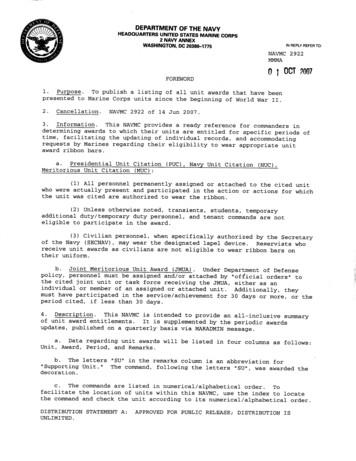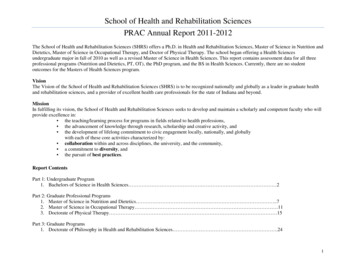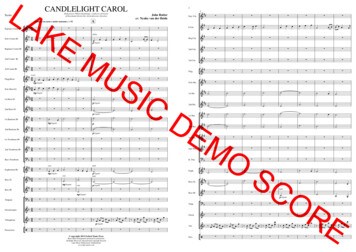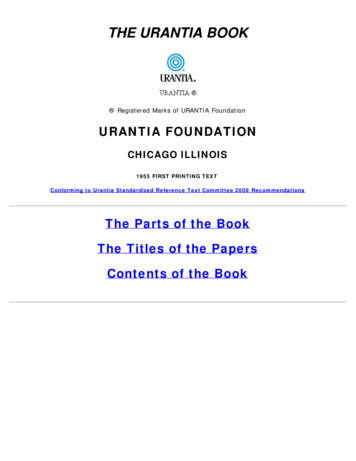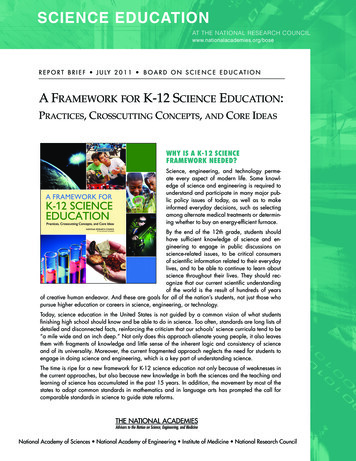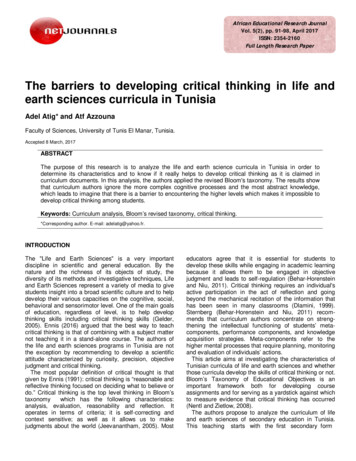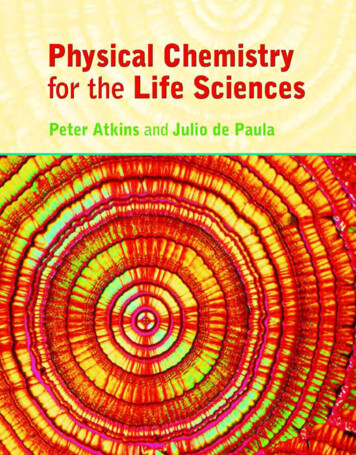
Transcription
Physical Chemistryfor the Life Sciences
This page intentionally left blank
Physical Chemistryfor the Life SciencesPeter AtkinsProfessor of Chemistry, Oxford UniversityJulio de PaulaProfessor of Chemistry, Haverford College1Oxford, UKW. H. Freeman and CompanyNew York
About the cover: Crystals of vitamin C (ascorbic acid) viewed by light microscopyat a magnification of 20x. Vitamin C is an important antioxidant, a substance thatcan halt the progress of cellular damage through chemical reactions with certainharmful by-products of metabolism. The mechanism of action of antioxidants is discussed in Chapter 10.Library of Congress Number: 2005926675 2006 by P.W. Atkins and J. de PaulaAll rights reserved.Printed in the United States of AmericaSecond printingPublished in the United States and Canada byW. H. Freeman and Company41 Madison AvenueNew York, NY 10010www.whfreeman.comISBN: 0-7167-8628-1EAN: 9780716786283Published in the rest of the world byOxford University PressGreat Clarendon StreetOxford OX2 6DPUnited Kingdomwww.oup.comISBN: 0-1992-8095-9EAN: 9780199280957
Contents in BriefPrologue 1Fundamentals7I Biochemical Thermodynamics 271 The First Law 282 The Second Law 763 Phase Equilibria 1044 Chemical Equilibrium 1515 Thermodynamics of Ion and Electron Transport 200II The Kinetics of Life Processes 2376 The Rates of Reactions 2387 Accounting for the Rate Laws 2658 Complex Biochemical Processes 296III Biomolecular Structure 3399 The Dynamics of Microscopic Systems 34010 The Chemical Bond 39411 Macromolecules and Self-Assembly 44112 Statistical Aspects of Structure and Change 502IV Biochemical Spectroscopy 53913 Optical Spectroscopy and Photobiology 53914 Magnetic Resonance 604AppendixAppendixAppendixAppendix1:2:3:4:Data sectionQuantities and units 643Mathematical techniques 645Concepts of physics 654Review of chemical principles 661669
ContentsPrologue1The structure of physical chemistry 1Applications of physical chemistry tobiology and medicine 2(a) Techniques for the study of biologicalsystems 2(b) Protein folding 3(c) Rational drug design 4(d) Biological energy conversion 5Fundamentals 7F.1 The states of matter 7F.2 Physical state 8F.3 Force 8F.4 Energy 9F.5 Pressure 10F.6 Temperature 13F.7 Equations of state 14Checklist of key ideas 23Discussion questions 23Exercises 23Project 25I Biochemical Thermodynamics 271 The First Law 28The conservation of energy 281.1 Systems and surroundings 291.2 Work and heat 291.3 Energy conversion in livingorganisms 321.4 The measurement of work 341.5 The measurement of heat 40Internal energy and enthalpy 431.6 The internal energy 431.7 The enthalpy 461.8 The temperature variation of theenthalpy 49Physical change 501.9 The enthalpy of phase transition 501.10 TOOLBOX: Differential scanningcalorimetry 54CASE STUDY 1.1: Thermal denaturationof a protein 56Chemical change 561.11 The bond enthalpy 571.12 Thermochemical properties offuels 601.13 The combination of reactionenthalpies 641.14 Standard enthalpies of formation 651.15 The variation of reaction enthalpy withtemperature 68Checklist of key ideas 71Discussion questions 72Exercises 72Project 752 The Second Law 76Entropy 772.1 The direction of spontaneouschange 772.2 Entropy and the Second Law 782.3 The entropy change accompanyingheating 802.4 The entropy change accompanying aphase transition 822.5 Entropy changes in thesurroundings 842.6 Absolute entropies and the Third Lawof thermodynamics 862.7 The standard reaction entropy 892.8 The spontaneity of chemicalreactions 90The Gibbs energy 912.9 Focusing on the system 912.10 Spontaneity and the Gibbs energy 92
viiContentsCASE STUDY 2.1: Life and the Second Lawof thermodynamics 932.11 The Gibbs energy of assembly ofproteins and biological membranes 93(a) The structures of proteins and biologicalmembranes 93(b) The hydrophobic interaction 952.12 Work and the Gibbs energy change 97CASE STUDY 2.2: The action of adenosinetriphosphateChecklist of key ideas 100Discussion questions 100Exercises 101Projects 1023 Phase Equilibria 104The thermodynamics of transition 1043.1 The condition of stability 1043.2 The variation of Gibbs energy withpressure 1053.3 The variation of Gibbs energy withtemperature 1083.4 Phase diagrams 109(a) Phase boundaries 110(b) Characteristic points 112(c) The phase diagram of water 114Phase transitions in biopolymers andaggregates 1153.5 The stability of nucleic acids andproteins 1163.6 Phase transitions of biologicalmembranes 119The thermodynamic description ofmixtures 1203.7 Measures of concentration 1203.8 The chemical potential 1243.9 Ideal solutions 1263.10 Ideal-dilute solutions 129CASE STUDY 3.1: Gas solubility andbreathing 1313.11 Real solutions: activities 133Colligative properties 1343.12 The modification of boiling andfreezing points 1343.13 Osmosis 1363.14 The osmotic pressure of solutions ofbiopolymers 138Checklist of key ideas 144Further information 3.1: The phase rule 145Discussion questions 146Exercises 146Projects 1494 Chemical Equilibrium 151Thermodynamic background 1514.1 The reaction Gibbs energy 1514.2 The variation of rG withcomposition 1534.3 Reactions at equilibrium 156CASE STUDY 4.1: Binding of oxygen tomyoglobin and hemoglobin 1594.4 The standard reaction Gibbsenergy 161The response of equilibria to theconditions 1644.5 The presence of a catalyst 1644.6 The effect of temperature 165Coupled reactions in bioenergetics 1664.7 The function of adenosinetriphosphate 167CASE STUDY 4.2: The biosynthesis ofproteins 1694.8 The oxidation of glucose 169Proton transfer equilibria 1744.9 Brønsted-Lowry theory 1744.10 Protonation and deprotonation 1744.11 Polyprotic acids 181CASE STUDY 4.3: The fractional composition ofa solution of lysine 1834.12 Amphiprotic systems 1864.13 Buffer solutions 189CASE STUDY 4.4: Buffer action in blood 191Checklist of key ideas 192Further information 4.1: The completeexpression for the pH of a solution ofa weak acid 193
viiiContentsDiscussion questions 194Exercises 194Projects 1985 Thermodynamics of Ion andElectron Transport 200Transport of ions across biologicalmembranes 2005.1 Ions in solution 2005.2 Passive and active transport of ionsacross biological membranes 2045.3 Ion channels and ion pumps 206CASE STUDY 5.1: Action potentials 207Redox reactions 2085.4 Half-reactions 2085.5 Reactions in electrochemical cells 2115.6 The Nernst equation 2145.7 Standard potentials 2175.8 TOOLBOX: The measurement of pH 222Applications of standard potentials 2235.9 The electrochemical series 2235.10 The determination of thermodynamicfunctions 223Electron transfer in bioenergetics 2275.11 The respiratory chain 2275.12 Plant photosynthesis 230Checklist of key ideas 232Discussion questions 232Exercises 233Project 2366.6 Integrated rate laws 249(a) First-order reactions 250CASE STUDY 6.1: Pharmacokinetics252(b) Second-order reactions 253The temperature dependence of reactionrates 2566.7 The Arrhenius equation 2566.8 Interpretation of the Arrheniusparamenters 258CASE STUDY 6.2: Enzymes and the accelerationof biochemical reactions 259Checklist of key ideas 260Discussion questions 260Exercises 260Project 2637 Accounting for the Rate Laws 265Reaction mechanisms 2657.1 The approach to equilibrium 2657.2 TOOLBOX: Relaxation techniques inbiochemistry 267CASE STUDY 7.1: Fast events in proteinfolding 2697.3 Elementary reactions 2707.4 Consecutive reactions 271(a) The variation of concentration with time 272(b) The rate-determining step 273(c) The steady-state approximation 274(d) Pre-equilibria 275CASE STUDY 7.2: Mechanisms of protein foldingand unfolding 277II The Kinetics of LifeProcesses 2376 The Rates of Reactions 238Reaction rates 2386.1 Experimental techniques 238(a) TOOLBOX: Spectrophometry 239(b) TOOLBOX: Kinetic techniques for fastbiochemical reations 2416.2 The definition of reaction rate 2436.3 Rate laws and rate constants 2446.4 Reaction order 2456.5 The determination of the rate law 2477.5 Diffusion control 278CASE STUDY 7.3: Diffusion control of enzyme-catalyzed reactions 2807.6 Kinetic and thermodynamiccontrol 280Reaction dynamics 2817.7 Collision theory 2817.8 Transition state theory 2837.9 The kinetic salt effect 286Checklist of key ideas 289Further information 7.1: Molecular collisions inthe gas phase 289
ixContentsDiscussion questions 291Exercises 291Projects 2948 Complex Biochemical Processes 296Transport across membranes 2968.1 Molecular motion in liquids 2968.2 Molecular motion acrossmembranes 3008.3 The mobility of ions 3028.4 TOOLBOX: Electrophoresis 3038.5 Transport across ion channels and ionpumps 306Enzymes 3088.6 The Michaelis-Menten mechanism ofenzyme catalysis 3098.7 The analysis of complexmechanisms 313CASE STUDY 8.1: The molecular basis ofcatalysis by hydrolytic enzymes 3148.8 The catalytic efficiency of enzymes 3168.9 Enzyme inhibition 317Electron transfer in biological systems 3208.10 The rates of electron transferprocesses 3218.11 The theory of electron transferprocesses 3238.12 Experimental tests of the theory 3248.13 The Marcus cross-relation 325Checklist of key ideas 328Further information 8.1: Fick’s laws ofdiffusion 329Discussion questions 330Exercises 331Projects 335III Biomolecular Structure 3399 The Dynamics of MicroscopicSystems 340Principles of quantum theory 3409.1 Wave-particle duality 3419.2 TOOLBOX: Electron microscopy 3449.3 The Schrödinger equation 3459.4 The uncertainty principle 347Applications of quantum theory 3509.5 Translation 350(a) The particle in a box 351CASE STUDY 9.1: The electronic structure of -carotene 354(b) Tunneling 355(c) TOOLBOX: Scanning probemicroscopy 3569.6 Rotation 358(a) A particle on a ring 358CASE STUDY 9.2: The electronic structure ofphenylalanine 360(b) A particle on a sphere 3619.7 Vibration: the harmonicoscillator 361CASE STUDY 9.3: The vibration of the NßHbond of the peptide link 363Hydrogenic atoms 3649.8 The permitted energies of hydrogenicatoms 3649.9 Atomic orbitals 366(a) Shells and subshells 367(b) The shapes of atomic orbitals 368The structures of many-electron atoms 3749.10 The orbital approximation and thePauli exclusion principle 3749.11 Penetration and shielding 3759.12 The building-up principle 3769.13 The configurations of cations andanions 3799.14 Atomic and ionic radii 380CASE STUDY 9.4: The role of the Zn2 ionin biochemistry 3829.15 Ionization energy and electronaffinity 383Checklist of key ideas 385Further information 9.1: A justification of theSchrödinger equation 387Further information 9.2: The Pauliprinciple 387Discussion questions 388Exercises 388Projects 392
xContents10 The Chemical Bond 394Valence bond theory 39410.1 Potential energy curves 39510.2 Diatomic molecules 39510.3 Polyatomic molecules 39710.4 Promotion and hybridization 39810.5 Resonance 402Molecular orbital theory 40410.6 Linear combinations of atomicorbitals 40210.7 Bonding and antibondingorbitals 40510.8 The building-up principle formolecules 40710.9 Symmetry and overlap 41010.10 The electronic structures ofhomonuclear diatomic molecules 413CASE STUDY 10.1: The biochemical reactivity ofO2 and N2 41410.11 Heteronuclear diatomicmolecules 416CASE STUDY 10.2: The biochemistryof NO 41810.12 The structures of polyatomicmolecules 419CASE STUDY 10.3: The unique role of carbon inbiochemistry 42110.13 Ligand-field theory 422CASE STUDY 10.4: Ligand-field theory and thebinding of O2 to hemoglobin 426Computational biochemistry 42710.14 Semi-empirical methods 42810.15 Ab initio methods and densityfunctional theory 43010.16 Graphical output 43110.17 The prediction of molecularproperties 431Checklist of key ideas 434Further information 10.1: The Pauli principleand bond formation 435Discussion questions 435Exercises 436Projects 43911 Macromolecules andSelf-Assembly 441Determination of size and shape 44111.1 TOOLBOX: Ultracentrifugation 44111.2 TOOLBOX: Mass spectrometry 44511.3 TOOLBOX: X-ray crystallography 447(a) Molecular solids 447(b) The Bragg law 451CASE STUDY 11.1: The structure of DNA fromX-ray diffraction studies 452(c) Crystallization of biopolymers 454(d) Data acquisition and analysis 455(e) Time-resolved X-ray crystallography 457The control of shape 45811.4 Interactions between partialcharges 45911.5 Electric dipole moments 46011.6 Interactions between dipoles 46311.7 Induced dipole moments 46611.8 Dispersion interactions 46711.9 Hydrogen bonding 46811.10 The total interaction 469CASE STUDY 11.2: Molecular recognition anddrug design 471Levels of structure 47311.11 Minimal order: gases and liquids 47311.12 Random coils 47411.13 Secondary structures of proteins 47711.14 Higher-order structures ofproteins 48011.15 Interactions between proteins andbiological membranes 48311.16 Nucleic acids 48411.17 Polysaccharides 48611.18 Computer-aided simulations 487(a) Molecular mechanics calculations 488(b) Molecular dynamics and Monte Carlosimulations 489(c) QSAR calculations 491Checklist of key ideas 493Further information 11.1: The van der Waalsequation of state 494Discussion questions 495Exercises 496Projects 500
xiContents12 Statistical Aspects of Structure andChange 502(b) Raman spectrometers 543(c) TOOLBOX: Biosensor analysisAn introduction to molecular statistics 50212.1 Random selections 50212.2 Molecular motion 504(a) The transition dipole moment 547(b) Linewidths 549(a) The random walk 504(b) The statistical view of diffusion 506Statistical thermodynamics 50612.3 The Bolzmann distribution 507(a) Instantaneous configurations 507(b) The dominating configuration 50954313.2 The intensity of a spectroscopictransition 544Vibrational spectra 55013.3 The vibrations of diatomic molecules 55013.4 Vibrational transitions 55213.5 The vibrations of polyatomicmolecules 55412.4 The partition function 510CASE STUDY 13.1: Vibrational spectroscopy of(a) The interpretation of the partitionfunction 511(b) Examples of partition functions 513(c) The molecular partition function 516proteins 55812.5 Thermodynamic properties 516(a) The internal energy and the heatcapacity 516CASE STUDY 12.1: The internal energy and heatcapacity of a biological macromolecule 518(b) The entropy and the Gibbs energy 520(c) The statistical basis of chemicalequilibrium 524Statistical models of protein structure 52612.6 The helix-coil transition inpolypeptides 52612.7 Random coils 529(a) Measures of size 529(b) Conformational entropy 532Checklist of key ideas 533Further information 12.1: The calculation ofpartition functions 534Further information 12.2: The equilibriumconstant from the partition function 535Discussion questions 535Exercises 536Project 538IV Biochemical Spectroscopy 53913 Optical Spectroscopy andPhotobiology 540General features of spectroscopy 54013.1 Experimental techniques 541(a) Light sources and detectors 54113.6 TOOLBOX: Vibrational microscopy560Ultraviolet and visible spectra 56213.7 The Franck-Condon principle 56313.8 TOOLBOX: Electronic spectroscopy ofbiological molecules 564Radiative and non-radiative decay 56713.9 Fluorescence andphosphorescence 56713.10 TOOLBOX: Fluorescencemicroscopy 56913.11 Lasers 57013.12 Applications of lasers inbiochemistry 571(a) TOOLBOX: Laser light scattering 571(b) TOOLBOX: Time-resolved spectroscopy 575(c) TOOLBOX: Single-molecule spectroscopy 576Photobiology 57713.13 The kinetics of decay of excitedstates 57813.14 Fluorescence quenching 581(a) The Stern-Volmer equation 581(b) TOOLBOX: Fluorescence resonance energytransfer 58413.15 Light in biology and medicine 586(a) Vision 586(b) Photosynthesis 588(c) Damage of DNA by ultraviolet radiation 589(d) Photodynamic therapy 590Checklist of key ideas 591Further information 13.1: Intensities inabsorption spectroscopy 592Further information 13.2: Examples of lasersystems 593
xiiContentsDiscussion questions 595Exercises 595Projects 60014 Magnetic Resonance 604Principles of magnetic resonance 60414.1 Electrons and nuclei in magneticfields 60514.2 The intensities of NMR and EPRtransitions 608The information in NMR spectra 60914.3 The chemical shift 61014.4 The fine structure 614CASE STUDY 14.1: Conformational analysisof polypeptides 61614.5 Conformational conversion andchemical exchange 618Pulse techiques in NMR 61914.6 Time- and frequency-domainsignals 61914.7 Spin relaxation 62214.8 TOOLBOX: Magnetic resonanceimaging 62414.9 Proton decoupling 62514.10 The nuclear Overhauser effect 62614.11 TOOLBOX: Two-dimensionalNMR 628CASE STUDY 14.2: The COSY spectrum ofisoleucine 632The information in EPR spectra 63314.12 The g-value 63414.13 Hyperfine structure 63514.14 TOOLBOX: Spin probes 637Checklist of key ideas 638Discussion questions 639Exercises 639Projects 641Appendix 1: Quantities and units 643Appendix 2: Mathematical techniques 645Basic procedures 645A2.1 Graphs 645A2.2 Logarithms, exponentials, andpowers 646A2.3 Vectors 647Calculus 648A2.4 Differentiation 648A2.5 Power series and Taylorexpansions 650A2.6 Integration 650A2.7 Differential equations 651Probability theory 652Appendix 3: Concepts of physics 654Classical mechanics 654A3.1 Energy 654A3.2 Force 655Electrostatics 656A3.3 The Coulomb interaction 656A3.4 The Coulomb potential 657A3.5 Current, resistance, and Ohm’slaw 657Electromagnetic radiation 658A3.6 The electromagnetic field 658A3.7 Features of electromagneticradiation 659Appendix 4: Review of chemicalprinciples 661A4.1 Amount of substance 661A4.2 Extensive and intensive properties 663A4.3 Oxidation numbers 663A4.4 The Lewis theory of covalentbonding 665A4.5 The VSEPR model 666Data section669Table 1: Thermodynamic data for organiccompounds 669Table 2: Thermodynamic data 672Table 3a: Standard potentials at 298.15 K inelectrochemical order 679Table 3b: Standard potentials at 298.15 K inalphabetical order 680Table 3c: Biological standard potentials at298.15 K in electrochemical order 681Table 4: The amino acids 682Answers to Odd-Numbered Exercises 683Index 688
Prefacehe principal aim of this text is to ensure that it presents all the material required for a course in physical chemistry for students of the life sciences, including biology and biochemistry. To that end we have provided the foundations and biological applications of thermodynamics, kinetics, quantum theory,and molecular spectroscopy.The text is characterized by a variety of pedagogical devices, most of them directed toward helping with the mathematics that must remain an intrinsic part ofphysical chemistry. One such device is what we have come to think of as a “bubble.” A bubble is a little flag on an equals sign to show how to go from the left ofthe sign to the right—as we explain in more detail in “About the Book,” whichfollows. Where a bubble has insufficient capacity to provide the appropriate levelof help, we include a Comment on the margin of the page to explain the mathematical procedure we have adopted.Another device that we have invoked is the Note on good practice. We consider that physical chemistry is kept as simple as possible when people use termsaccurately and consistently. Our Notes emphasize how a particular term should andshould not be used (by and large, according to IUPAC conventions). Finally, background information from mathematics, physics, and introductory chemistry is reviewed in the Appendices at the end of the book.Elements of biology and biochemistry are incorporated into the text’s narrative in a number of ways. First, each numbered section begins with a statement thatplaces the concepts of physical chemistry about to be explored in the context oftheir importance to biology. Second, the narrative itself shows students how physical chemistry gives quantitative insight into biology and biochemistry. To achievethis goal, we make generous use of illustrations (by which we mean quick numerical exercises) and worked examples, which feature more complex calculations thando the illustrations. Third, a unique feature of the text is the use of Case studies todevelop more fully the application of physical chemistry to a specific biological orbiomedical problem, such as the action of ATP, pharmacokinetics, the unique roleof carbon in biochemistry, and the biochemistry of nitric oxide. Finally, in The biochemist’s toolbox sections, we highlight selected experimental techniques in modern biochemistry and biomedicine, such as differential scanning calorimetry, gelelectrophoresis, fluorescence resonance energy transfer, and magnetic resonanceimaging.A text cannot be written by authors in a vacuum. To merge the languages ofphysical chemistry and biochemistry, we relied on a great deal of extraordinarilyuseful and insightful advice from a wide range of people. We would particularly liketo acknowledge the following people who reviewed draft chapters of the text:TSteve Baldelli, University of HoustonMaria Bohorquez, Drake UniversityD. Allan Cadenhead, SUNY–BuffaloMarco Colombini, University of MarylandSteven G. Desjardins, Washington and Lee UniversityKrisma D. DeWitt, Mount Marty Collegexiii
xivPrefaceThorsten Dieckman, University of California–DavisRichard B. Dowd, Northland CollegeLisa N. Gentile, Western Washington UniversityKeith Griffiths, University of Western OntarioJan Gryko, Jacksonville State UniversityArthur M. Halpern, Indiana State UniversityMike Jezercak, University of Central OklahomaThomas Jue, University of California–DavisEvguenii I. Kozliak, University of North DakotaKrzysztof Kuczera, University of KansasLennart Kullberg, Winthrop UniversityAnthony Lagalante, Villanova UniversityDavid H. Magers, Mississippi CollegeSteven Meinhardt, North Dakota State UniversityGiuseppe Melacini, McMaster UniversityCarol Meyers, University of Saint FrancisRuth Ann Cook Murphy, University ofMary Hardin–BaylorJames Pazun, Pfeiffer UniversityEnrique Peacock-López, Williams CollegeGregory David Phelan, Seattle Pacific UniversityJames A. Phillips, University of Wisconsin–Eau ClaireCodrina Victoria Popescu, Ursinus CollegeDavid Ritter, Southeast Missouri State UniversityJames A. Roe, Loyola Marymount UniversityReginald B. Shiflett, Meredith CollegePatricia A. Snyder, Florida Atlantic UniversitySuzana K. Straus, University of British ColumbiaRonald J. Terry, Western Illinois UniversityMichael R. Tessmer, Southwestern CollegeJohn M. Toedt, Eastern Connecticut State UniversityCathleen J. Webb, Western Kentucky UniversityFfrancon Williams, The University of TennesseeKnoxvilleJohn S. Winn, Dartmouth CollegeWe have been particularly well served by our publishers and wish to acknowledge our gratitude to our acquisitions editor, Jessica Fiorillo, of W. H. Freeman andCompany, who helped us achieve our goal.PWA, OxfordJdeP, Haverford
About the BookThere are numerous features in this text that are designed to help you learnphysical chemistry and its applications to biology, biochemistry, and medicine. One of the problems that makes the subject so daunting is the sheeramount of information. To help with that problem, we have introduced several devices for organizing the material: see Organizing the information. We appreciate thatmathematics is often troublesome and therefore have included several devices forhelping you with this enormously important aspect of physical chemistry: see Mathematics support. Problem solving—especially, “where do I start?”—is often a problem, and we have done our best to help you find your way over the first hurdle: seeProblem solving. Finally, the Web is an extraordinary resource, but you need to knowwhere to go for a particular piece of information; we have tried to point you in theright direction: see Web support. The following paragraphs explain the features inmore detail.Organizing the informationChecklist of key ideas. Here we collectthe major concepts that we have introduced in the chapter. You might like tocheck off the box that precedes eachentry when you feel that you are confidentabout the topic.Checklist of Key IdeasYou should now be familiar with the following concepts:䊐 1. Deviations from ideal behavior in ionic solutionsare ascribed to the interaction of an ion with itsionic atmosphere.䊐 2. According to the Debye-Hückel limiting law, themean activity of ions in a solution is related tothe ionic strength, I, of the solution by log A兩z z 兩I1/2.䊐 3. The Gibbs energy of transfer of an ion across acell membrane is determined by an activity gradientand a membrane potential difference, ,that arises from differences in Coulombrepulsions on each side of the bilayer: Gm RT ln([A]in/[A]out) zF .Case studies. We incorporate generalconcepts of biology and biochemistrythroughout the text, but in some cases itis useful to focus on a specific problem in somedetail. Each Case Study contains some background information about a biological process,such as the action of adenosine triphosphate orthe metabolism of drugs, followed by a series ofcalculations that give quantitative insight intothe phenomena.The biochemist’s toolbox. A Toolbox contains descriptions of some of the modern techniques of biology, biochemistry, and medicine.In many cases, you will use these techniques inlaboratory courses, so we focus not on the operation of instruments but on the physical principles that make the instruments perform aspecific task.䊐䊐䊐䊐䊐7. The electromotive force of a cell is the potentialdifference it produces when operating reversibly:E rG/ F.8. The Nernst equation for the emf of a cell isE E両 (RT/ F) ln Q.9. The standard potential of a couple is thestandard emf of a cell in which it forms the righthand electrode and a hydrogen electrode is on theleft. Biological standard potentials are measured inneutral solution (pH 7).10. The standard emf of a cell is the difference ofits standard electrode potentials: E両 ER両 EL両 orE丣 ER丣 EL丣.11. The equilibrium constant of a cell reactionCASE STUDY 5.1 Action potentialsA striking example of the importance of ion channels is their role in the propagation of impulses by neurons, the fundamental units of the nervous system. Herewe give a thermodynamic description of the process.The cell membrane of a neuron is more permeable to K ions than to eitherNa or Cl ions. The key to the mechanism of action of a nerve cell is its use ofNa and K channels to move ions across the membrane, modulating its potential. For example, the concentration of K inside an inactive nerve cell is about20 times that on the outside, whereas the concentration of Na outside the cell1.10 Toolbox: Differential scanning calorimetryWe need to describe experimental techniques that can be used to observe phasetransitions in biological macromolecules.A differential scanning calorimeter11 (DSC) is used to measure the energy transferred as heat to or from a sample at constant pressure during a physical or chemical change. The term “differential” refers to the fact that the behavior of the sample is compared to that of a reference material that does not undergo a physical orchemical change during the analysis. The term “scanning” refers to the fact thatthe temperatures of the sample and reference material are increased, or scanned,systematically during the analysis.xv
xviAbout the BookA note on good practice: Write units at every stage of a calculation and do not simply attach them to a final numerical value. Also, it is often sensible to express allnumerical quantities in terms of base units when carrying out a calculation. DERIVATION 5.2 The Gibbs energy of transfer of an ion across amembrane potential gradientThe charge transferred per mole of ions of charge number z that cross a lipid bilayer is NA (ze), or zF, where F eNA. The work w of transporting thischarge is equal to the product of the charge and the potential difference :w zF Provided the work is done reversibly at constant temperature and pressure, wecan equate this work to the molar Gibbs energy of transfer and write Gm zF Adding this term to eqn 5.7 gives eqn 5.8, the total Gibbs energy of transfer ofan ion across both an activity and a membrane potential gradient.Notes on good practice. Science is a precise activity, andusing its language accurately can help you to understand theconcepts. We have used this feature to help you to use thelanguage and procedures of science in conformity to international practice and to avoid common mistakes.Derivations. On first reading you might need the “bottomline” rather than a detailed derivation. However, once youhave collected your thoughts, you might want to go back tosee how a particular expression was obtained. The Derivationslet you adjust the level of detail that you require to your current needs. However, don’t forget that the derivation ofresults is an essential part of physical chemistry, and shouldnot be ignored.Further information. In some cases, we have judged that aderivation is too long, too detailed, or too difficult in levelfor it to be included in the text. In these cases, you will findthe derivation at the end of the chapter.Appendices. Physical chemistry draws on a lot of background material, especiallyin mathematics and physics. We have included a set of Appendices to provide aquick survey of some of the information that we draw on in the text.Mathematics supportBubbles. You often need toConstant heat capacityknow how to develop a mathTfTfdTTCdTematical expression, but how S C C ln fTTTiTiTido you go from one line to thenext? A “bubble” is a littlereminder about the approximation that has been used, the terms that have beentaken to be constant, the substitution of an expression, and so on.冕COMMENT 5.1 TheCoulomb interaction betweentwo charges q1 and q2 separatedby a distance r is described byCOMMENT 1.11 The the Coulombic potential energy:text’s web site contains linksqqto online databases ofEP 1 24 0rthermochemical data,including enthalpies ofwhere 0 8.854 10 12 J 1combustion and standard C2 m 1 is the vacuumenthalpies of formation. permittivity. Note that theinteraction is attractive(EP 0) when q1 and q2 haveopposite signs and repulsiveCOMMENT 3.4 The series(EP 0) when the chargesexpansion of a naturallogarithm (see Appe
Physical Chemistry for theLife Sciences Peter Atkins Professor of Chemistry, Oxford University Julio de Pau
